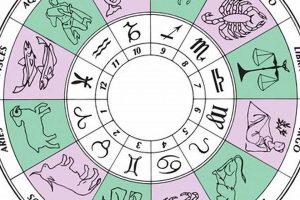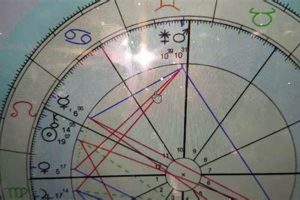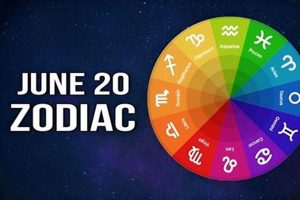On June 3rd of various years, specific planetary alignments occur within our solar system. These alignments, as interpreted through the lens of astrology, are often seen as significant celestial events. For example, a conjunction, where planets appear close together from Earth’s perspective, might be interpreted astrologically depending on the planets involved and their traditional symbolic meanings.
Historically, celestial events have held cultural and symbolic weight, inspiring mythology, religious beliefs, and even agricultural practices. In astrology, planetary positions are believed to influence human affairs and terrestrial events. Certain alignments are considered to hold greater importance due to the perceived combined influence of the planets involved. These events can offer opportunities for reflection and introspection, prompting individuals to consider broader perspectives.
The following sections will explore specific instances of planetary alignments occurring on June 3rd in different years, analyzing their potential astrological significance and exploring historical interpretations. Discussions will delve into the involved planets’ symbolic meanings and their possible impact on various aspects of life.
Tips for Understanding Planetary Alignments
Planetary alignments offer opportunities for reflection and understanding. These tips provide guidance on interpreting such events, focusing on the astrological perspective.
Tip 1: Research the Specific Planets Involved: Each planet carries symbolic meaning in astrology. Understanding these meanings provides a foundation for interpreting an alignment’s significance. For example, a Mars-Jupiter alignment might be interpreted differently than a Venus-Saturn alignment.
Tip 2: Consider the Astrological Signs: The zodiac signs in which the planets are positioned during the alignment add another layer of interpretation. A planet’s influence can be expressed differently depending on the sign it occupies.
Tip 3: Consult Reputable Astrological Resources: Books, websites, and experienced astrologers can offer valuable insights into the nuances of planetary alignments. Seek sources that provide well-reasoned interpretations.
Tip 4: Reflect on Personal Experience: Consider how previous planetary alignments have coincided with personal experiences. This can provide a personalized framework for understanding future alignments.
Tip 5: Avoid Making Concrete Predictions: Astrology offers potential interpretations, not definitive predictions. Use astrological insights as a tool for self-reflection and understanding, not as a blueprint for the future.
Tip 6: Focus on Self-Development: Planetary alignments can be seen as opportunities for growth and change. Use these events as prompts for introspection and self-improvement.
Tip 7: Maintain a Balanced Perspective: While astrology can offer valuable insights, it’s important to integrate these insights with other perspectives and maintain a balanced approach to life decisions.
By considering these tips, one can approach planetary alignments with greater understanding and integrate their potential meaning into a broader life context.
These insights offer a framework for understanding the significance of planetary alignments in astrology. The concluding section will summarize key concepts and offer further resources for exploration.
1. Celestial Mechanics
Celestial mechanics forms the foundational scientific basis for understanding planetary alignments, including those occurring on June 3rd. This branch of astronomy deals with the motions and gravitational interactions of celestial bodies. It provides the precise positions of planets at any given time, which astrologers then interpret symbolically.
- Orbital Dynamics
Planetary orbits, governed by gravitational forces, determine their positions in the solar system. Orbital periods, shapes, and inclinations influence the frequency and nature of alignments. For example, the relatively short orbital period of Mercury compared to that of Saturn means Mercury participates in more frequent alignments. Understanding orbital dynamics allows for predicting when and how planets will align from Earth’s perspective, a key element for astrological interpretation.
- Geocentric Perspective
Astrology interprets planetary positions from a geocentric perspective, meaning as viewed from Earth. While celestial mechanics can describe alignments from any viewpoint, the Earth-centered view is crucial for astrological significance. For instance, a June 3rd alignment might appear differently from Mars than from Earth, leading to varying astrological interpretations.
- Conjunctions and Aspects
Celestial mechanics provides the angular separation between planets. Astrology defines specific angular relationships, called aspects, as having particular significance. A conjunction, where planets appear close together in the sky, is a prime example. Celestial mechanics calculates the precise degree of separation during a conjunction, informing astrological interpretation.
- Ephemerides and Astronomical Data
Ephemerides, calculated using celestial mechanics, provide detailed tables of planetary positions over time. These data are essential tools for astrologers, allowing them to determine the exact configuration of planets on any given date, such as June 3rd. Accurate astronomical data are crucial for precise astrological analysis.
By providing precise planetary positions, celestial mechanics enables the identification and analysis of specific alignments, such as those occurring on June 3rd. This astronomical framework is essential for understanding the underlying geometry of planetary configurations, which then allows for astrological interpretation and exploration of potential symbolic meanings.
2. Astrological Chart
An astrological chart, also known as a natal chart or horoscope, serves as a map of the celestial positions at a specific moment in time. In the context of June 3rd planetary alignments, the astrological chart created for that date depicts the precise locations of the planets within the zodiac and their angular relationships. This chart provides the foundation for astrological interpretations of the alignment’s potential significance.
- Houses
The astrological chart is divided into twelve houses, each representing a different area of life, such as career, relationships, or finances. The placement of planets within these houses on June 3rd adds another layer of interpretation to the alignment. For example, a Venus-Mars conjunction in the seventh house might be interpreted differently than the same conjunction in the second house. The houses provide a framework for understanding how a planetary alignment might manifest in different areas of life.
- Zodiac Signs
The zodiac signs, twelve 30-degree segments along the ecliptic, provide the backdrop for planetary placements. Each sign possesses unique characteristics, influencing the expression of planetary energies. A June 3rd alignment with Mars in Aries might be interpreted differently than one with Mars in Libra. The zodiac signs provide a nuanced context for understanding the qualities of a planetary alignment.
- Aspects
Aspects refer to the angular relationships between planets in the astrological chart. Conjunctions, oppositions, squares, and trines are examples of aspects that astrologers consider significant. The aspects formed by planets during a June 3rd alignment contribute to its interpretation. For instance, a Jupiter-Saturn square might be interpreted differently than a Jupiter-Saturn trine. Aspects reveal the dynamic interplay between planetary energies.
- Planetary Positions
The precise positions of the planets in degrees and minutes within each sign are essential data points in the astrological chart. These precise positions are essential for calculating aspects and understanding the nuances of a June 3rd planetary alignment. The chart reveals which planets are prominent and how their combined energies might manifest.
The astrological chart provides a comprehensive picture of the celestial landscape on June 3rd. By analyzing the houses, signs, aspects, and planetary positions within the chart, astrologers can interpret the potential significance of any planetary alignments occurring on that date. This interpretation offers insights into the potential energies and themes associated with the alignment.
3. Planetary Influence
Planetary influence forms a core principle within astrology, suggesting that celestial bodies exert subtle yet impactful energies on human affairs and terrestrial events. In the context of a June 3rd planetary alignment, understanding the individual influences of the involved planets is crucial for interpreting the alignment’s overall significance. This involves considering each planet’s inherent astrological symbolism and how these energies might interact and combine during the alignment.
- Archetypal Energies
Each planet is associated with specific archetypal energies. For example, Mars represents action and drive, while Venus symbolizes love and harmony. During a June 3rd alignment involving these planets, these archetypal energies come into play. A Mars-Venus conjunction might suggest a dynamic interplay between passion and affection, while a Mars-Venus square could indicate tension between these forces. Understanding these archetypal energies provides a foundation for interpreting the alignment’s potential impact.
- Combined Influence
A planetary alignment involves the combined influence of multiple celestial bodies. The specific combination of planets involved on June 3rd shapes the overall energetic signature of the alignment. A Jupiter-Saturn alignment, for instance, carries different implications than a Mercury-Neptune alignment. The interplay of planetary energies creates a complex tapestry of potential influences.
- Sign Placement
The zodiac sign a planet occupies during a June 3rd alignment modifies its expression. Mars in Aries expresses its fiery energy differently than Mars in Cancer. This nuance is essential for understanding how planetary influences manifest. A Venus-Jupiter conjunction in Taurus might be interpreted differently than the same conjunction in Sagittarius, as the signs shape the expression of these planetary energies.
- Aspects
The angular relationships, or aspects, between planets during a June 3rd alignment further refine the interpretation of planetary influence. A harmonious trine between planets suggests a flowing integration of energies, while a challenging square might indicate tension or conflict. The aspects formed during the alignment reveal the dynamic interplay between the involved planets.
By considering the archetypal energies, combined influences, sign placements, and aspects involved in a June 3rd planetary alignment, astrologers can develop a deeper understanding of its potential significance. This analysis provides a nuanced perspective on how these celestial events might manifest in individual lives and collective experiences.
4. Symbolic Interpretation
Symbolic interpretation forms the core of astrological practice, providing a framework for understanding the potential meaning and influence of planetary alignments, including those occurring on June 3rd. Astrology assigns symbolic meanings to planets, signs, houses, and aspects, weaving these together to create a narrative of potential influence. This interpretive lens allows for exploring the potential themes and energies associated with specific alignments.
- Planetary Symbolism
Each planet embodies specific symbolic qualities. Mars, for example, represents action, energy, and drive, while Venus symbolizes love, beauty, and harmony. During a June 3rd alignment involving these planets, their symbolic meanings intertwine. A Mars-Venus conjunction might be interpreted as a period of passionate engagement, while a Mars-Venus square could signify conflict between assertive desires and relational needs. Understanding the inherent symbolism of each planet provides a foundation for interpreting the alignment.
- Zodiacal Influences
The zodiac signs in which planets reside during a June 3rd alignment further color their symbolic meanings. Mars in Aries expresses its energy with directness and impulsivity, while Mars in Libra may manifest as a more diplomatic and balanced approach to assertion. A June 3rd alignment with Venus in Taurus might emphasize sensual pleasures and material security, whereas Venus in Scorpio could highlight themes of intense intimacy and transformation. The zodiac signs provide a nuanced context for interpreting planetary symbolism.
- Archetypal Resonance
Planetary alignments evoke archetypal patterns of human experience. A Saturn-Uranus alignment, for instance, might symbolize the tension between tradition and innovation or the interplay between structure and change. A June 3rd alignment involving these planets might be interpreted as a period of societal shifts and breakthroughs, where established norms are challenged by new ideas. Recognizing the archetypal resonance of planetary combinations provides deeper insight into their potential influence.
- Cultural Context
Symbolic interpretations of planetary alignments can vary across cultures and historical periods. While some core symbolic meanings remain consistent, cultural context shapes how these meanings are understood and applied. For example, a June 3rd alignment involving Jupiter might be interpreted differently in a culture that associates Jupiter with prosperity and expansion compared to one that emphasizes its philosophical or spiritual dimensions. Cultural context adds depth and complexity to astrological interpretation.
By synthesizing planetary symbolism, zodiacal influences, archetypal resonance, and cultural context, astrologers interpret the potential meaning of June 3rd planetary alignments. This symbolic interpretation offers valuable insights into potential themes, challenges, and opportunities associated with these celestial events. This understanding can then be applied to individual experiences and collective dynamics, providing a framework for navigating the unfolding narrative of life.
5. Historical Context
Examining historical context provides crucial insights into interpreting planetary alignments within astrology, specifically those occurring on June 3rd. Ancient cultures closely observed celestial events, attributing significant meaning to planetary positions and alignments. These historical interpretations, though often intertwined with mythology and religious beliefs, offer valuable perspectives on the perceived influence of specific planetary configurations. For example, in Babylonian astrology, Venus held associations with both love and war, depending on its celestial relationships with other planets. A June 3rd alignment involving Venus and Mars might have been interpreted differently in ancient Babylon compared to later Hellenistic traditions, reflecting evolving astrological systems.
Understanding how past cultures viewed specific planetary alignments informs contemporary astrological interpretations. Historical texts, astronomical records, and archaeological evidence offer glimpses into the evolving understanding of celestial influences. Analyzing historical perspectives can illuminate recurring themes and symbolic associations related to specific planets and their alignments. For instance, Jupiter has historically been associated with expansion, good fortune, and rulership. A June 3rd alignment involving Jupiter might be interpreted in light of these historical associations, considering how different cultures viewed Jupiter’s influence in specific contexts. Examining historical perspectives also reveals how astrological interpretations have evolved over time, reflecting changing cultural values and scientific advancements.
Integrating historical context provides a richer and more nuanced understanding of planetary alignments in astrology. By acknowledging the historical significance attributed to celestial events, contemporary astrologers can draw upon a wealth of accumulated knowledge and interpretative frameworks. This historical lens adds depth to the analysis of June 3rd alignments, offering valuable insights into the potential symbolic meanings and cultural resonance of these celestial events. It allows for a deeper appreciation of the enduring human fascination with the cosmos and its perceived influence on human affairs.
6. Personal Significance
Planetary alignments, including those occurring on June 3rd, gain personal significance through their interaction with individual birth charts. A birth chart, representing the precise planetary positions at the moment of birth, provides a unique astrological blueprint. A June 3rd alignment’s impact varies depending on how it resonates with an individual’s natal planetary placements. This personalized interpretation explores the potential influence of the alignment on various life areas, offering insights into potential challenges and opportunities for growth.
- Natal Chart Interactions
The personal significance of a June 3rd planetary alignment stems from its interaction with an individual’s natal chart. If the alignment activates sensitive points in the birth chart, such as planetary positions or house cusps, its influence may be more pronounced. For example, a June 3rd transit of Mars conjunct one’s natal Venus could stimulate romantic relationships or creative endeavors. Conversely, if the alignment forms challenging aspects to natal planets, it might manifest as tension or conflict in corresponding life areas. Analyzing the interplay between the June 3rd alignment and the natal chart provides a personalized understanding of its potential impact.
- Life Areas Affected
Different planetary alignments emphasize different life themes. A June 3rd alignment involving planets in the fourth house might highlight family and home matters, while one involving planets in the tenth house could impact career and public image. The houses activated by the alignment provide clues to the life areas most likely to be affected. For example, a June 3rd transit of Jupiter through the second house might bring opportunities for financial growth, while a Saturn transit through the seventh house could signify challenges in relationships. The specific planets involved further refine the interpretation, adding layers of nuance to the personal significance of the alignment.
- Potential Challenges and Opportunities
Planetary alignments can present both challenges and opportunities. A June 3rd alignment forming challenging aspects to natal planets might bring difficulties to navigate, requiring adaptation and resilience. However, these challenges can also stimulate personal growth and lead to valuable lessons. Conversely, harmonious alignments could bring opportunities for expansion and fulfillment in specific life areas. For example, a June 3rd transit of Venus trine natal Jupiter could bring joy and abundance, while a Mars square natal Saturn might present obstacles to overcome. Recognizing the potential challenges and opportunities associated with the alignment allows for proactive navigation and informed decision-making.
- Personal Growth and Transformation
Astrology views planetary alignments as catalysts for personal growth and transformation. By understanding the potential influence of a June 3rd alignment on one’s birth chart, individuals can gain insights into their current life path and identify areas ripe for development. For example, a June 3rd transit of Uranus square natal Sun could signify a period of significant change and upheaval, prompting a reevaluation of personal identity and life direction. By engaging consciously with the energies of the alignment, individuals can harness its transformative potential for self-discovery and evolution.
By considering these factors, individuals can gain a deeper understanding of how a June 3rd planetary alignment might personally affect them. This personalized interpretation allows for integrating the astrological influences into one’s life narrative, offering insights for self-reflection, growth, and navigating life’s unfolding journey.
7. Future Implications
Planetary alignments, including those occurring on June 3rd, offer a prospective lens through which potential future trends and influences can be explored within the framework of astrology. While not predictive in a concrete sense, these alignments provide symbolic insights into potential energetic shifts and themes that may unfold in the future. Examining these future implications encourages reflection on potential growth areas, challenges to navigate, and opportunities to embrace.
- Collective Shifts
Certain planetary alignments are believed to correlate with broader societal shifts and transformations. A June 3rd alignment involving slow-moving outer planets, such as Uranus, Neptune, or Pluto, might suggest long-term societal changes related to the themes represented by these planets. For example, a Uranus transit through a sign could indicate a period of technological advancements or social upheaval, while a Neptune transit might signify shifts in collective consciousness or spiritual values. A June 3rd alignment activating these planetary influences could signal potential turning points in societal evolution.
- Personal Development
Planetary alignments offer insights into potential future growth areas for individuals. A June 3rd alignment forming harmonious aspects to natal planets could suggest periods of personal expansion and opportunity. For instance, a Jupiter transit through a house in one’s birth chart might signify potential growth and abundance in the areas associated with that house. Recognizing these potential opportunities allows individuals to proactively engage with these energies and maximize their potential for personal development.
- Navigating Challenges
Planetary alignments can also highlight potential future challenges. A June 3rd alignment forming challenging aspects to natal planets might indicate areas where difficulties or obstacles may arise. For example, a Saturn transit through a house could present lessons related to responsibility, limitations, or the need for structure in that area of life. Understanding these potential challenges allows for preparation, resilience, and proactive strategies for navigating potential difficulties.
- Cycles and Recurring Themes
Planetary cycles play a significant role in astrology, often presenting recurring themes and patterns throughout life. A June 3rd alignment might activate a particular planetary cycle, offering insights into potential future developments related to that cycle. For instance, a Jupiter return, occurring approximately every twelve years, often signifies a period of expansion and opportunity. A June 3rd alignment coinciding with a Jupiter return could amplify its themes of growth and abundance. Understanding these cyclical influences provides a broader context for interpreting the potential future implications of a June 3rd alignment.
By considering these potential future implications, individuals can approach planetary alignments with greater awareness and intention. While astrology does not offer concrete predictions, it provides a valuable tool for reflection, self-discovery, and navigating life’s unfolding journey with greater insight and understanding. The future implications of a June 3rd alignment encourage individuals to engage consciously with the celestial influences and make choices aligned with their personal growth and aspirations.
Frequently Asked Questions
This section addresses common inquiries regarding the astrological interpretations of planetary alignments, specifically those occurring on June 3rd.
Question 1: Do planetary alignments on June 3rd cause specific events to happen?
Astrology does not posit a causal relationship between planetary alignments and events. Alignments are interpreted as symbolic reflections of potential energies and influences, not as direct causes. One might consider them as opportunities for introspection rather than predictors of specific outcomes.
Question 2: How do astrologers determine the significance of a June 3rd planetary alignment?
Astrologers analyze the specific planets involved, their positions in the zodiac, the houses they occupy in the astrological chart, and the aspects they form with each other. These factors, combined with historical and cultural context, contribute to the interpretation of the alignment’s potential meaning.
Question 3: Does everyone experience a June 3rd planetary alignment the same way?
Individual experiences of a planetary alignment are influenced by one’s natal chart, the unique astrological blueprint created at the moment of birth. The alignment’s interaction with individual planetary placements and houses shapes its personal significance.
Question 4: Are June 3rd planetary alignments always significant?
The significance of a June 3rd alignment depends on the specific planets involved and their astrological configurations. Some alignments may be considered more potent or impactful than others due to the symbolism and historical associations of the planets and their aspects.
Question 5: Can predictions be made based on June 3rd planetary alignments?
Astrology focuses on interpretation and potential influences, not concrete predictions. Alignments offer insights into potential energies and themes, but individual choices and external factors also play significant roles in shaping outcomes.
Question 6: How can one best utilize the information provided by astrological interpretations of June 3rd alignments?
Astrological insights can be used for self-reflection, personal growth, and understanding potential life themes. They offer opportunities for introspection and conscious engagement with one’s life path.
Understanding these common inquiries fosters a more nuanced perspective on the astrological interpretations of June 3rd planetary alignments. These interpretations offer symbolic insights for self-reflection and understanding, not definitive predictions or causal explanations.
This concludes the FAQ section. The following section will explore specific examples of June 3rd planetary alignments in different years.
June 3rd Planet Alignment Astrology
Planetary alignments occurring on June 3rd offer a rich field of study within astrology. This exploration has delved into the multifaceted aspects of such alignments, from the foundational celestial mechanics that determine planetary positions to the symbolic interpretations that imbue these events with meaning. The significance of specific June 3rd alignments is understood through an intricate interplay of planetary symbolism, zodiacal influences, house placements, and aspects. Furthermore, historical context illuminates the evolving interpretations of these celestial events across cultures and time periods, providing a deeper understanding of their potential influence on human experience. Personal significance emerges through the interaction of these alignments with individual birth charts, offering personalized insights into potential life themes, challenges, and opportunities. Finally, considering future implications encourages reflection on potential growth areas and collective shifts.
Celestial events continue to captivate human imagination, prompting exploration of potential meanings and influences. Astrological interpretations of June 3rd planetary alignments provide a framework for understanding these celestial configurations, offering a lens through which individuals can engage with broader cosmic patterns and their potential resonance in personal lives. Further research and exploration within this field promise deeper insights into the intricate relationship between celestial mechanics and human experience.







